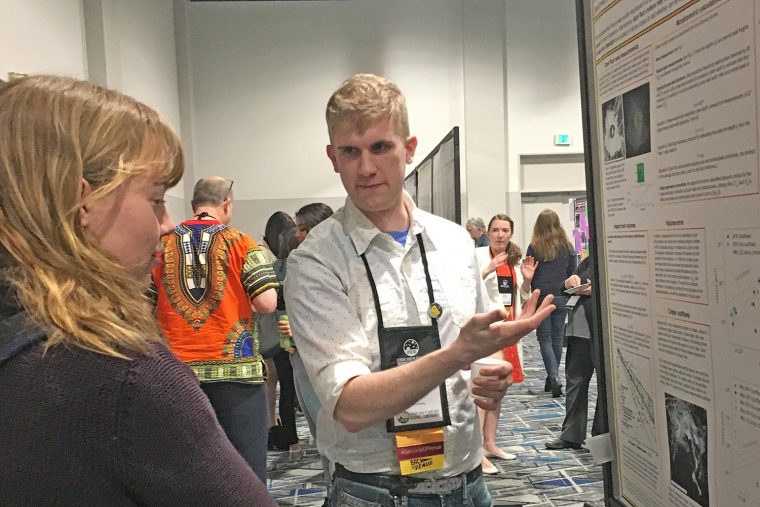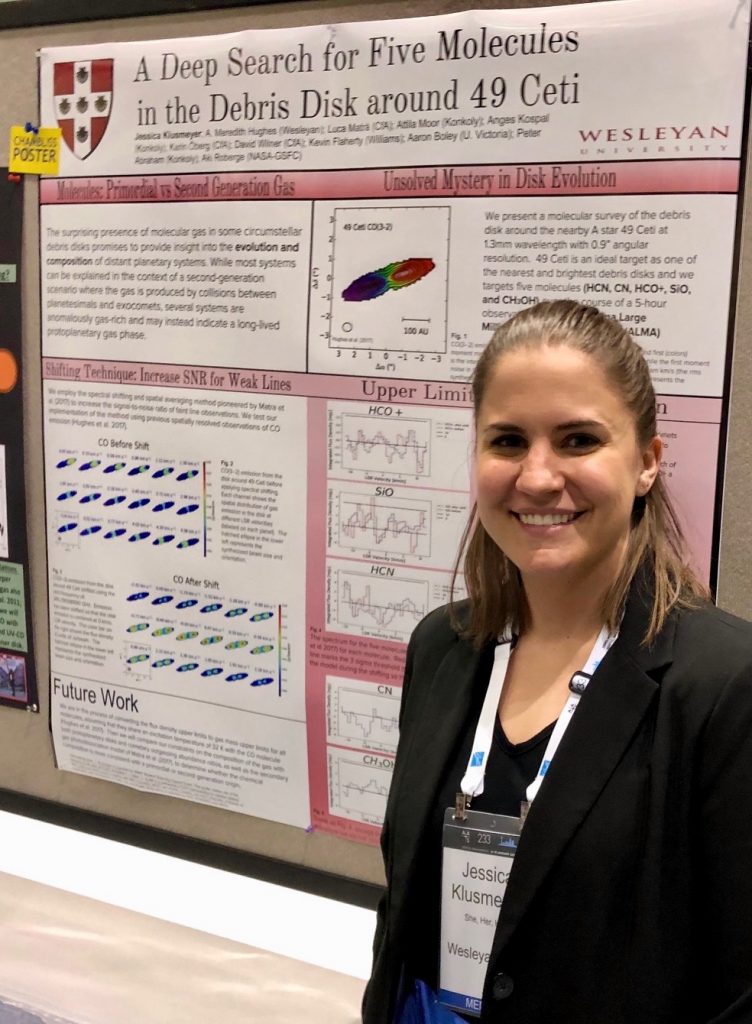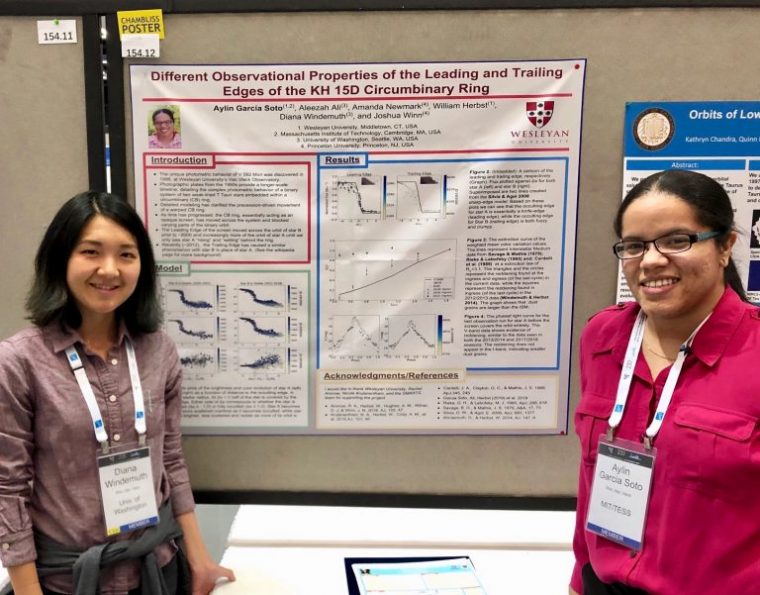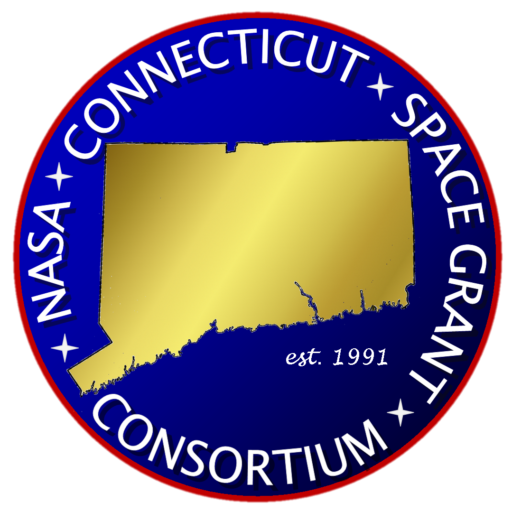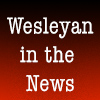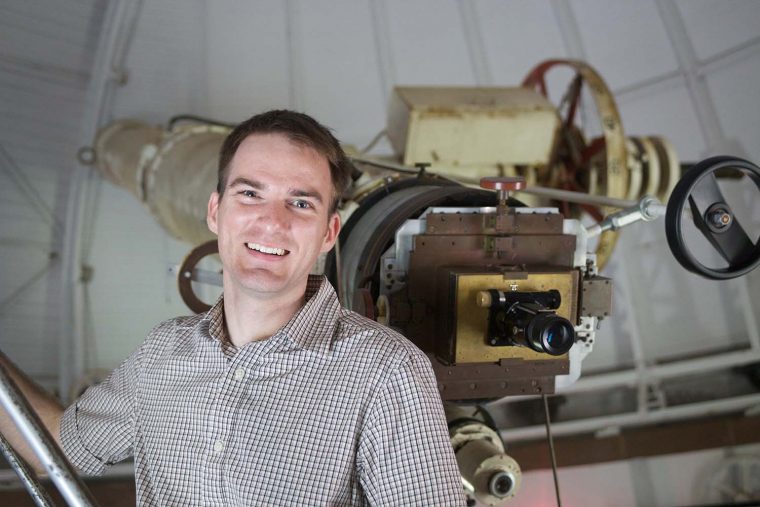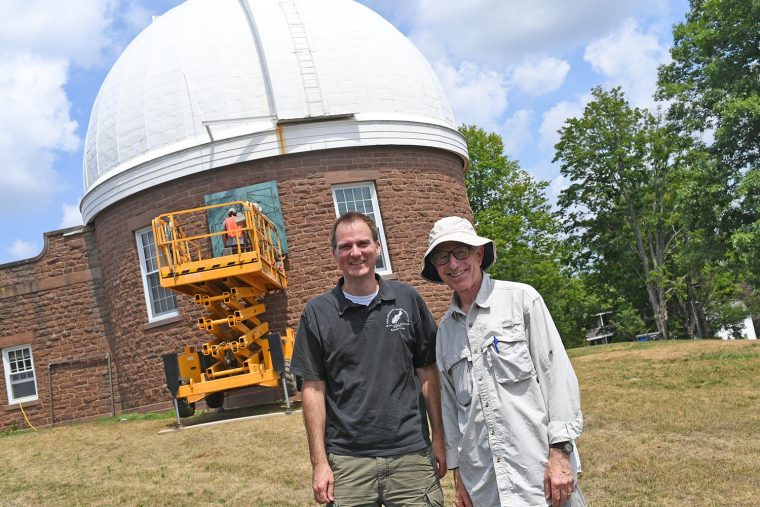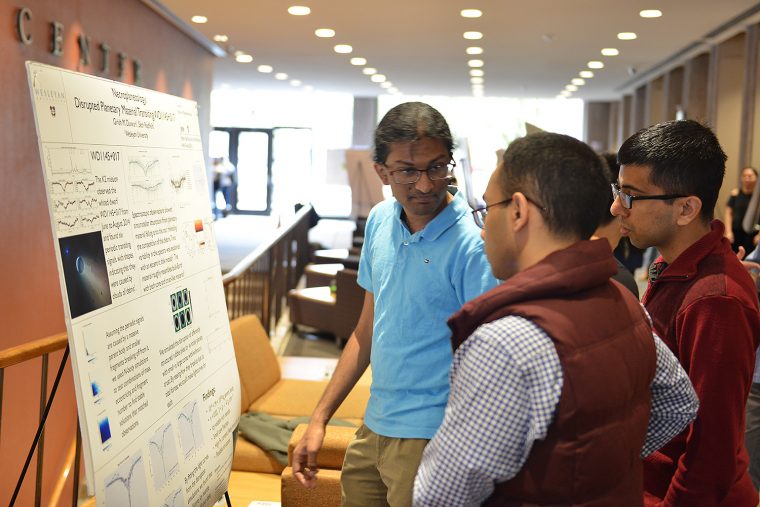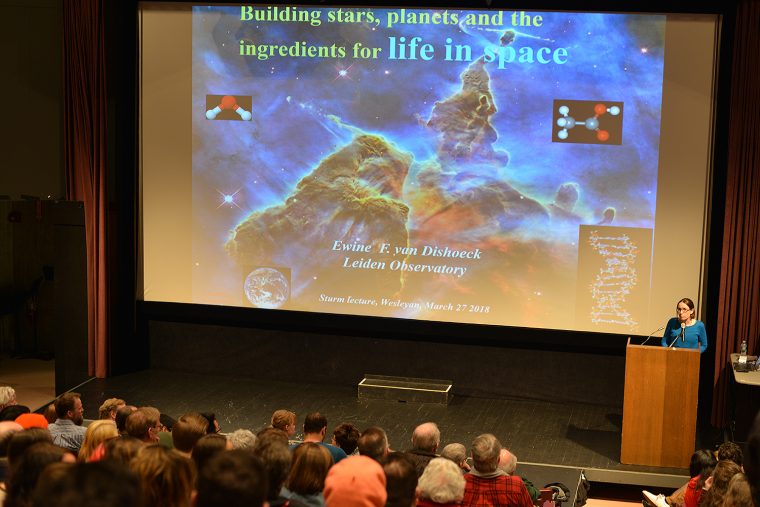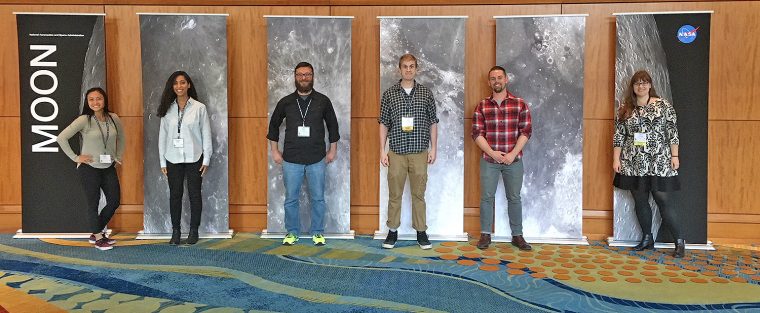Several Wesleyan students, faculty, and alumni attended the 50th Lunar and Planetary Science Conference (LPSC) March 18-22 in The Woodlands, Texas. Members of the Wesleyan Planetary Sciences Group presented their research on a range of planetary bodies. This annual conference brings together international specialists in petrology, geochemistry, geophysics, geology, and astronomy to present the latest results of research in planetary science. Earth and environmental studies major Emmy Hughes '20 presented a poster titled “Observations of Transverse Aeolian Ridges in Digital Terrain Models" during a session on “Planetary Aeolian Processes.” Earth and environmental science graduate student Reid Perkins MA '19 presented a…
After a star forms, a dusty ring of space debris may begin orbiting around a star. These circumstellar disks are composed of asteroids or collision fragments, cosmic dust grains, and gasses. Astronomy graduate student Jessica Klusmeyer is interested in understanding the molecular composition of the debris disk gas. "It has important implications not only for our knowledge of debris disks but also for planet formation," she said. Klusmeyer joined more than 25 Wesleyan affiliates and shared her research during the 233rd American Astronomical Society Meeting Jan. 6-10 in Seattle, Wash. The American Astronomical Society (AAS) awarded Klusmeyer a Chambliss medal for her poster presentation…
More than 25 Wesleyan affiliates attended the 233rd American Astronomical Society Meeting Jan. 6-10 in Seattle, Wash. All current Wesleyan students who attended presented posters of their research. Campus attendees included: Bill Herbst, the John Monroe Van Vleck Professor of Astronomy and professor, integrative sciences; Roy Kilgard, associate professor of the practice in astronomy and associate professor of the practice, integrative sciences; Michael Henderson '19; Allison Quintana '19; graduate student Jessica Klusmeyer; graduate student Ismael Mireles; and graduate student Anthony Santini ’18. Alumni included Hannah Fritze ’18, Aylin Garcia Soto ’18, Prajwal Niraula MA ’18, Amy Steele MA ’14, Nicole Arulanantham MA…
Two graduate students and three undergraduate students are recipients of Fall 2018 NASA Connecticut Space Grant Consortium (CTSGC) awards. They are among 39 students from 13 CTSGC academic affiliate institutions to be honored. NASA CTSGC is a federally mandated grant, internship, and scholarship program that is funded as a part of NASA Education. There are Space Grant Consortia in all 50 states, plus Washington, D.C., and Puerto Rico. Earth and environmental science graduate student Christina Cauley received an $8,000 Graduate Research Fellowship for her project “Chemistry and Biology of Giant Hydrothermal Mounds in Paulina Lake, Oregon." Her advisor is Joop…
In this recurring feature in The Wesleyan Connection, we highlight some of the latest news stories about Wesleyan and our alumni. Recent Wesleyan News 1. Los Angeles Times: "As the World Warms, Deadly and Disfiguring Tropical Diseases Are Inching Their Way Toward the U.S." In this op-ed, Professor of Biology Frederick Cohan and Isaac Klimasmith '20, both in the College of the Environment, write that infectious disease is a growing threat, resulting from climate change, that humans may find hard to ignore. Cohan is also professor, environmental studies and professor, integrative sciences. 2. Hartford Courant: "Trump's Immoral Response to Climate Report" Gary Yohe, the…
On Oct. 15, Seth Redfield, associate professor and chair of astronomy, gave a lecture at the Morrison Planetarium at the California Academy of Sciences. He was invited to speak as part of the Benjamin Dean Astronomy Lecture series. The title of his talk was, "Exploring Our Galactic Neighborhood." The talk will be posted to the Academy's iTunes University site. Redfield is also associate professor, integrative sciences, and co-coordinator, planetary science.
The campus community now has the ability to tell time the way Egyptians did more than 3.500 years ago—by using light and shadows. A modern-day sundial, which mimics those used throughout history, now hangs on the south side of the Van Vleck Observatory’s 24-inch Perkin telescope. The six-foot-square structure is fabricated from 3/16-inch thick Muntz metal bronze with stainless steel reinforcing. "Campus doesn't have enough outside art," said Joyce Jacobsen, provost and senior vice president for academic affairs. "A sundial is a perfect piece because it's not only aesthetically pleasing but it's functional too." Bill Herbst, John Monroe Van Vleck Professor of…
In recognition of his exemplary research at Wesleyan, astronomy major Girish Duvvuri ’17 has been awarded a Chambliss medal from the American Astronomical Society (AAS). Duvvuri, who majored in astronomy, physics, and English, received the award during the 232nd AAS Meeting June 3–7 in Denver, Colo. There, he presented a study that formed much of his senior thesis at Wesleyan. Seth Redfield, associate professor and chair of astronomy, associate professor of integrative sciences, and co-coordinator of planetary science, served as Duvvuri's advisor. To be eligible for an award, work featured on a poster must have been done within the past year and while the presenter was an…
Three undergraduates and one graduate student received NASA Connecticut Space Grant Awards from the NASA Connecticut Space Grant Consortium (CTSGC). The CTSGC is a federally mandated grant, internship, and scholarship program that aims to inspire the pursuit of careers in science, technology, engineering, and mathematics. Astronomy and math major Nicole Zalewski '20 received a $5,000 undergraduate research fellowship to pursue her study on “Measurement of the Radar Properties of the Oldest Rocks on Venus to Constrain Mineralogy." Her advisor is Martha Gilmore, the George I. Seney Professor of Geology, professor of earth and environmental sciences, co-coordinator of planetary science, and…
The Association of Universities for Research in Astronomy (AURA), which operates the Hubble Space Telescope, the James Webb Space Telescope, the U.S. National Optical Astronomy Observatory (NOAO), and other major astronomical research facilities in the United States, has elected the Keck Northeast Astronomy Consortium (KNAC)—led by Wesleyan University—as a new member. This historic development represents the first time that liberal arts institutions have been invited to join the association and serves as an important recognition of the value of such programs, not just to education, but also to frontier research in astronomy. “This is a tremendous recognition of the important…
(more…)
Faculty, graduate students, and alumni attended the 49th Lunar and Planetary Science Conference March 19–23 in The Woodlands, Texas. Three graduate students were awarded funds from the NASA Connecticut Space Grant that allowed them to travel to this meeting. Earth and environmental sciences graduate student Reid Perkins presented a research poster titled "Where Are the Missing Tessera Craters on Venus?" Perkins's advisor is Martha Gilmore, the George I. Seney Professor of Geology, professor of earth and environmental sciences. Earth and environmental sciences graduate student Melissa Luna presented a poster titled "Multivariate Spectral Analysis of CRISM Data to Characterize the Composition of Mawrth…


